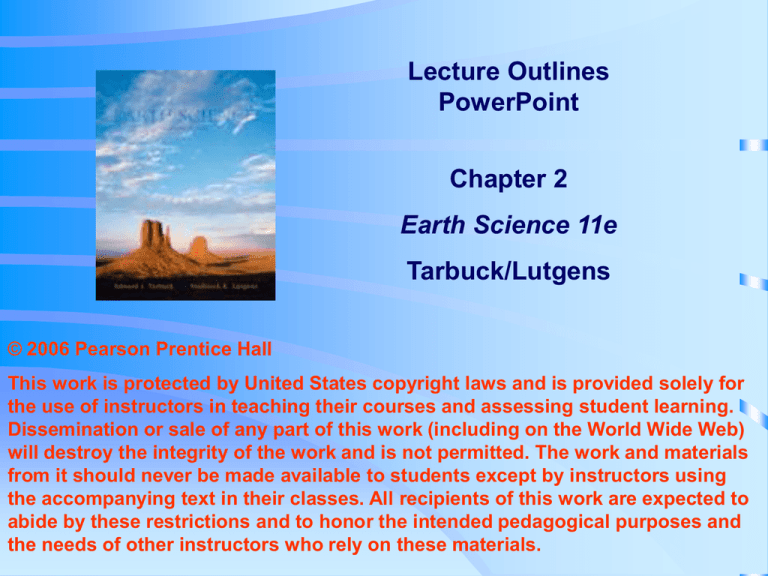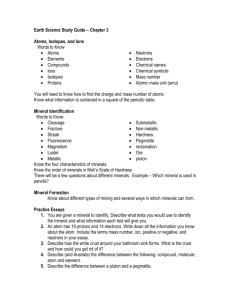
Lecture Outlines
PowerPoint
Chapter 2
Earth Science 11e
Tarbuck/Lutgens
© 2006 Pearson Prentice Hall
This work is protected by United States copyright laws and is provided solely for
the use of instructors in teaching their courses and assessing student learning.
Dissemination or sale of any part of this work (including on the World Wide Web)
will destroy the integrity of the work and is not permitted. The work and materials
from it should never be made available to students except by instructors using
the accompanying text in their classes. All recipients of this work are expected to
abide by these restrictions and to honor the intended pedagogical purposes and
the needs of other instructors who rely on these materials.
Earth Science, 11e
Minerals: Building
Blocks of Rocks
Chapter 2
EARTH SCIENCE 170, 171
B Murphy, G Ferguson
JAMIE BRAID
RM 2006
Email : jamie.braid@gmail.com
Tutorials
•
•
•
•
Collette Rennie
4-5pm Wednesdays / Thursdays
NH 120
Starting the 17th
Minerals: the building
blocks of rocks
Definition of a mineral
•
•
•
•
•
Natural
Inorganic
Solid
Possess an orderly internal structure of atoms
Have a definite chemical composition
Mineraloid - lacks an orderly internal
structure
• Minerals and rocks are the basic
components of the Solid Earth
Composition and
structure of minerals
Elements
• Basic building blocks of minerals
• Over 100 are known
Atoms
• Smallest particles of matter
• Have all the characteristics of an element
Periodic table of the Elements
Figure 2.4
How atoms are constructed
Nucleus – central part of
an atom that contains
• Protons – positive
electrical charges,
properties
• Neutrons – neutral
electrical charges
Energy levels, or shells
• orbit nucleus
• Contain electrons –
negative electrical charges
Elements
• Made in stars
• building blocks of minerals
• made up of atoms,
– central nucleus (protons and
neutrons)
–orbiting electrons
Elements
• Numbered 1 to 92, depending on
protons
• 1 to 26 made during life of stars
• 27 to 92, in supernova
• protons dictate properties
• electrons more loosely bound,
• bonding of elements to form
Periodic table of the Elements
Figure 2.4
Simplified view of the atom
Figure 2.5
How atoms are constructed
Atomic number is the number of protons in
an atom's nucleus
Bonding of atoms
• Forms a compound with two or more elements
• Ions are atoms that gain or lose electrons
Isotopes
• Have varying number of neutrons
Periodic table of the Elements
Figure 2.4
END NIGHT CLASS
Octet Rule
• Elements most stable with 8
electrons in their outer shell
• most elements have < 8
• therefore they have a
tendency to bond
Types of bonds
• IONIC-transfer of electron
• COVALENT-shared electrons
• METALLIC-Common cloud of
shared electrons (metals)
• van der Waals-bonding between
adjacent molecules
Ionic bonding NaCl
COVALENT
Periodic table of the Elements
Figure 2.4
Composition of continental crust
Not oxygen in the
air
Figure 2.16
99.9%
Composition of Earth’s Crust
•
•
•
•
•
•
•
•
O
Si
Al
Fe
Ca
Na
K
Mg
46.6 (wt%)
27.7
8.1
5.0
3.6
2.8
2.6
2.1
62.6 (atoms)
21.2
6.5
1.9
1.9
2.6
1.4
1.8
The silicate (SiO4)-4 molecule
Charge imbalance
Figure 2.17
Leggo building
block for the earth
Silicate tetrahedron
The physical properties
of minerals
Color and streak
crystal form
hardness
cleavage and fracture
specific gravity and density
hardness
Fe-Mg silicates
DARK
Non Fe-Mg silicates
Little Iron and Magnesium
The physical properties
of minerals
Color and streak
crystal form
hardness
cleavage and fracture
specific gravity and
density
The mineral quartz often
exhibits good crystal form
Pyrite (fool’s gold)
displays metallic luster
Figure 2.10
Mineral crystals
External shape = internal bonding
The physical properties
of minerals
Color and streak
crystal form
hardness
cleavage and fracture
specific gravity and density
hardness
Diamond (Hard) Graphite (Soft)
How on can we form both???
GOLD ~ soft
Mohs scale
of hardness
Figure 2.12
The physical properties
of minerals
Color and streak
crystal form
hardness
cleavage and fracture
specific gravity and density
Silicate tetrahedron
Physical Properties
Reflect internal weakness in
structure and chemical
Breaking weak bonds
Three examples of perfect
cleavage – fluorite, halite,
and calcite
Weak planes parallel to edges (analogous to splitting wood)
Most minerals are silicates
• Silicon and oxygen
in a tetrahedral
arrangement
• variety of metallic
ions bonded
Silicate tetrahedron
Silicate minerals
UNUSED
Conchoidal fracture
Figure 2.15
Minerals
Physical properties of minerals
• Fracture
• Specific gravity
• Other properties
•
•
•
•
Taste
Smell
Elasticity
Malleability
Minerals
Mineral groups
• Rock-forming silicates
• Groups based upon tetrahedral arrangement
• Olivine – independent tetrahedra
• Pyroxene group – tetrahedra are arranged in
chains
• Amphibole group – tetrahedra are arranged in
double chains
Hornblende – a member of
the amphibole group
Minerals
Mineral groups
• Rock-forming silicates
• Groups based upon tetrahedral arrangement
• Micas – tetrahedra are arranged in sheets
• Two types of mica are biotite (dark) and
muscovite (light)
• Feldspars - Three-dimensional network of
tetrahedra
Minerals
Mineral groups
• Rock-forming silicates
• Groups based upon tetrahedral arrangement
• Feldspars
• Two types of feldspar are Orthoclase and
Plagioclase
• Quartz – three-dimensional network of
tetrahedra
Potassium feldspar
Plagioclase feldspar
Minerals
Mineral groups
• Rock-forming silicates
• Feldspars are the most plentiful mineral group
• Crystallize from molten material
• Nonsilicate minerals
• Major groups
• Oxides
• Sulfides
Minerals
Mineral groups
• Nonsilicate minerals
• Major groups
• Sulfates
• Carbonates
• “Native” elements
Native Copper
Minerals
Mineral groups
• Nonsilicate minerals
• Carbonates
• A major rock-forming group
• Found in the rocks limestone and marble
• Halite and gypsum are found in sedimentary rocks
• Many have economic value
Minerals
Mineral resources
• Reserves are already identified deposits
• Ores are useful metallic minerals that can be
mined at a profit
• Economic factors may change and influence a
resource
An underground halite (salt) mine
End of Chapter 2









